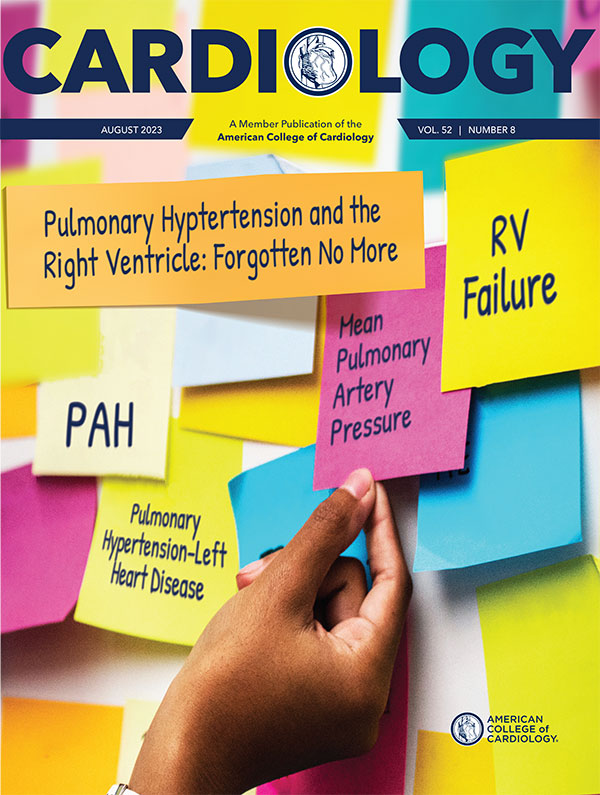Health Equity in Action | Improving Outcomes For Black Americans Living With PAD

Approximately 8.5 million persons in the U.S. are diagnosed with peripheral artery disease (PAD), with (by far) the highest prevalence and the most advanced disease presentation in Black Americans, who experience clear racial disparities in treatment and outcomes.1,2
Poor outcomes are rationalized by lifestyle choices (e.g., smoking), access to health care, health literacy and socioeconomic position. Yet, when accounting for these factors, odds of greater disease still remain higher compared to other racial/ethnic groups.3,4
If these factors are all we address, we will not eliminate these disparities and associated disparate outcomes in Black Americans. To achieve health equity in PAD, we must identify and unpack structural health barriers.5
To forge a path to health equity, it is imperative that we identify and understand not just the what, but the how and the why of inequities. We may learn, for example, that a patient cannot take off work for medical appointments. We may learn that a patient lives in a neighborhood without adequate transportation infrastructure.
We may find that an employed patient without health insurance cannot afford screening, diagnostics and/or medications. We may discover there is inadequate walking space to comply with exercise recommendations. Unfortunately, these risks disproportionately affect many Black Americans and, as such, lend themselves to analysis using the socioecological model.
The four-level socioecological model considers the complex interplay between 1) individual, 2) relationships, 3) community and 4) societal factors. The overlapping rings illustrate how factors at one level influence factors at another. This systems-thinking approach can link the societal consequences of structural health inequity to PAD outcomes.6-8 A depiction of the socioecological model levels and the biological impact on PAD outcomes is shown in the Figure.

Racism, Risk and PAD
Black Americans have a two- to three-fold higher prevalence of PAD compared with Hispanic and non-Hispanic Whites.9 Black race significantly increases the risk of amputation within the same socioeconomic stratum compared with White race, and has an independent effect on limb loss after controlling for relevant comorbidities, severity of PAD at presentation and use of medications.10
Racism indelibly defines socially constructed racial groups to enroot disparities.11 The Black race phenotype in the U.S. has historically been, for many, associated with poor living conditions, substandard education, cyclical poverty and incarceration.12 Racism impacts education, neighborhood configuration and economic opportunity, broadly acknowledged as foundational for healthy living.11
The fact that inequities in access to and delivery of care by race continue to be prevalent should not surprise. However, use of the socioecological framework to connect social disparity to biological impact and then to clinical inequities will help us better understand the effect of marginalization based on race. Once societal risk is added to the enhanced conceptualization of clinical risk, we can better deconstruct medical systems to evaluate for health care injustice.13-16
Considering racism as a structural component of social determinants of health (SDOH) is not political rhetoric. Rather, it is an essential consideration for a Black person's health and their health care approach and delivery. By identifying where in the medical system racism exists, we can start to better understand how to dismantle and rebuild a new and more equitable system.
Clinical algorithms based on blood pressure, hemoglobin A1C, LDL-C and ankle-brachial index (ABI) are inadequate to fully encompass the spectrum of risk unique to the Black American experience. Atherosclerosis, the most common underlying cause of lower extremity PAD, reflects a pathologic integration of immune dysregulation, inflammatory amplification, lipid metabolism, neurohumoral activation, endothelial dysfunction and oxidative stress.17-20 Societal inequities are integrated with risk related to these biological mechanisms.
Notable works have exposed how structural inequities have permeated the quality of health care delivered to Black Americans. Under the Skin draws on Linda Villarosa's decades of investigative reporting of the differences in health outcomes among Black Americans compared to other racial/ethnic groups.21 Villarosa shares captivating stories of people's real-life experiences interacting with the health care system and subsequent outcomes.

Appropriately, she notes that "Black Americans have long lived under the tremendous emotional pressure in the face of bias and inequality, much of it sanctioned by the government and embedded in the structure and institutions of society since the earliest days of the country."
Similarly, authors Rupa Marya and Raj Patel penned Inflamed-Deep Medicine and the Anatomy of Injustice, a systems-based review of human biology – the digestive, endocrine, cardiovascular, respiratory, reproductive, immune and nervous systems – to explore the hidden connections between our biological systems and the deep-rooted injustices of our political and economic systems.22
The authors acknowledge that "racism in medicine influences who has access to care, how much care they receive, and the financial burden they will carry as a consequence of care." They pointedly note the role of inflammation, stating "…chronic illnesses that disproportionately impact Black American families all have inflammation involved in their pathogenesis. Discrimination, [posttraumatic stress disorder], and adverse childhood events all set adults up for chronic inflammation, mediated through pathways of stress."
When we report racial disparities in disease outcomes, it is equally important to acknowledge necessary investigation into stress-inducing experiences which may contribute to health outcomes. The lived experience of many Black Americans includes chronic stressors from financial volatility and biased social policies.23
The unsafe built environment, worsened by gentrification, climate change and policing strategies, increases exposure to triggers of atherosclerosis such as stress, air pollutants and heavy metals, which magnify barriers to effective care.24-26
Nutritional injustice, inequitable resources, pollution and insufficient educational opportunities are well-described as consequences of racism.27, 28 The health care system was not designed to resolve the ills of society or the government. However, the identification and reporting of disparities, coupled with efforts to do what is possible in the scope of health care to dismantle them, is a promising start.
Another core issue is that Black Americans have difficulty acquiring culturally relatable care.29 The medical system has a documented history of oppression and exploitation of Black Americans, the ripple effects of which reverberate as mistrust in public health initiatives, research endeavors and the clinical space.30,31
Ineffective health care encounters are exacerbated by lack of providers who share a similar lived perspective.32 Disappointingly, there is continued evidence that some medical trainees and students continue to consider racially constructed groups as biologically distinct.33-35 The paucity of Black American medical students, primary care providers, cardiologists and vascular specialists contributes to disparity.36,37
There is underutilization of diagnostics, guideline-directed therapies and limb-salvage.38 Social vulnerabilities enhance risk from tobacco use, hypertension, dyslipidemia, diabetes and chronic kidney disease.
The impact of racism within the socioecological model elevates the discussion beyond oversimplification of health literacy, access, affordability and allocation as primary factors of SDOH. Using this framework, it is not surprising that Black Americans suffer from higher-than-expected rates of asymptomatic PAD, functional impairment and amputation.3,39
Health Justice and PAD: Societal Solutions, Research and Policy
PAD Legislation on the Move
Legislation to help reduce unnecessary and preventable amputations associated with PAD is now moving through the House of Representatives. The Amputation Reduction and Compassion Act would ensure at-risk Medicare and Medicaid beneficiaries receive coverage for PAD screening as well as improve education and awareness of PAD through a new U.S. Department of Health and Human Services PAD program.
Click here for the latest calls to action and support this legislation.
A retrospective investigation of the National Surgical Quality Improvement Database over a seven-year period from 2011 to 2017 revealed that Black Americans are 93.3% more likely to undergo a below-knee amputation than White patients.40
Further, Black Americans with PAD were found to have a 133% higher risk of an above-knee amputation than White patients. In this analysis, amputations were greatest among Black Americans undergoing surgery for critical limb ischemia (CLI) secondary to atherosclerosis. There was also an elevated risk of amputation secondary to diabetes, PAD and deep soft-tissue infections.
Black Americans are less likely to undergo vascular testing (ABI, toe pressure, imaging) than White Americans before major lower extremity amputation. In addition to the immense psychologic toll of an amputation, the annual cost of care in the U.S. for amputees to society is estimated to exceed $4.3 billion.41,42
Average annual expenditures per individual for patients with PAD are approximately $11,553 compared with $4,219 for those without PAD. Expenditures are further increased by prescription medication expenditures as well as by expenditures for inpatient care, outpatient hospital-based care and outpatient office-based care. These expenditures compound lost wages, care by family members and lost opportunity costs, increasing the burden carried by patients with PAD.
Socioeconomic status, particularly employment status, health insurance coverage and the inability to afford treatment, are noted barriers among Black Americans in seeking health care services.43 The average Black American household possesses approximately six to eight cents of wealth compared to every dollar of wealth held by the average White American household.12

This immense Black-White wealth gap is based on historical legacies of racist policies and practices such as redlining, not individual choices such as frivolous spending or single parenthood. Black Americans were systematically excluded from the practices that propelled the accumulation of White wealth and which continue to affect not only social and financial outcomes, but health as well.12
Systems-level solutions must be collaborative, actionable and sustainable, consisting of culturally aware health promotion, changes in public policy, and acceptance of the need for dialogue regarding restorative justice, food justice and environmental justice. Educational systems must demonstrate and encourage health care career pathway development opportunities in primary and secondary education and ensure appropriate scholarship and mentorship support during undergraduate and graduate medical education.
Furthermore, health care systems must develop a workforce that demonstrates effective communication, inclusive methodologies and implicit bias recognition for the patients it serves, considering their unique needs, perspectives and goals of living. Another essential component of this change is the use of implementation science, the scientific study of methods to promote the systematic uptake of research findings and other evidence-based practice into routine practice.44
While there are great data regarding the deployment of interventions, the means of successfully scaling and adjusting these interventions in diverse clinical settings and among diverse populations are lacking. Using an iterative approach, we can start to understand what is effective and ineffective, and thus make necessary adaptations in partnership with communities.
Society needs to invest in the health care future of Black Americans suffering from the socioecological and clinical consequences of racism. Allocation of funds should mandate inclusion of the community voice and prioritize racially concordant and relatable translational, clinical and public health research. We should be cautious in the applications of outcomes from databases and clinical trials that underrepresent the experience of Black Americans.
Socioecological disparity is systemic, cyclical and intergenerational, requiring health care solutions that integrate multi-sector and multi-policy approaches requiring seats of diversity at the table to achieve population health justice.45 Reckoning with our intentionality is the path we must walk together to enact the necessary infrastructure to reimagine a society devoid of health disparities in PAD for Black Americans. It is a matter of life and limb.


This perspective was authored by Demetria M. McNeal, PhD, MBA, and James E. Carter Jr., MD, FACC, from the School of Medicine, Department of Medicine, University of Colorado Anschutz Medical Campus, from the Division of General Internal Medicine and Division of Cardiology, respectively, in Aurora, CO.
References
- Shu J, Santulli G. Update on peripheral artery disease: Epidemiology and evidence-based facts. Atherosclerosis 2018;275:379-81.
- Allison MA, Criqui MH, McClelland RL, et al. The effect of novel cardiovascular risk factors on the ethnic-specific odds for peripheral arterial disease in the Multi-Ethnic Study of Atherosclerosis (MESA). J Am Coll Cardiol 2006;48:1190-7.
- Arya S, Binney Z, Khakharia A, et al. Race and socioeconomic status independently affect risk of major amputation in peripheral artery disease. J Am Heart Assoc 2018;7:e007425.
- Hackler EL 3rd, Hamburg NM, White Solaru KT. Racial and ethnic disparities in peripheral artery disease. Circ Res 2021;128:1913-26.
- Javed Z, Haisum Maqsood M, Yahya T, et al. Race, racism, and cardiovascular health: Applying a social determinants of health framework to racial/ethnic disparities in cardiovascular disease. CirculationCardiovasc Qual Outcomes 2022;15:e007917.
- Whittemore R, Melkus GDE, Grey M. Applying the social ecological theory to type 2 diabetes prevention and management. J Community Health Nurs;21:87-99.
- Kolff CA, Scott VP, Stockwell MS. The use of technology to promote vaccination: A social ecological model based framework. Hum Vaccin Immunother 2018;14:1636-46.
- Nuss HJ, Hester LL, Perry MA, et al. Applying the social ecological model to creating asthma‐friendly schools in Louisiana. J School Health 2016;86:225-32.
- Allison MA, Ho E, Denenberg JO, et al. Ethnic-specific prevalence of peripheral arterial disease in the United States. Am J Prev Med 2007;32:328-33.
- Arya S, Binney Z, Khakharia A, et al. Race and socioeconomic status independently affect risk of major amputation in peripheral artery disease. J Am Heart Assoc 2018;7(2).
- Bailey ZD, Feldman JM, Bassett MT. How structural racism works—racist policies as a root cause of US racial health inequities. New Engl J Med 2021;384:768-73.
- Hudson D, Sacks T, Irani K, et al. The price of the ticket: Health costs of upward mobility among African Americans. Int J Environ Res Public Health 2020;17(4):1179.
- Acosta D, Ackerman-Barger K. Breaking the silence: Time to talk about race and racism. Acad Med 2017;92:285-8.
- Bailey ZD, Krieger N, Agénor M, et al. Structural racism and health inequities in the USA: Evidence and interventions. Lancet. 2017;389:1453-63.
- Churchwell K, Elkind MSV, Benjamin RM, et al. Call to action: Structural racism as a fundamental driver of health disparities: A presidential advisory from the American Heart Association. Circulation 2020;142:e454-e468.
- Paradies Y, Ben J, Denson N, et al. Racism as a determinant of health: A systematic review and meta-analysis. PLoS One 2015;10:e0138511.
- Ross R. Cell biology of atherosclerosis. Annu Rev Physiol 1995;57:791-804.
- Ross R. The pathogenesis of atherosclerosis—an update. N Engl J Med 1986;314:488-500.
- Libby P, Ridker PM, Maseri A. Inflammation and atherosclerosis. Circulation 2002;105:1135-43.
- Hansson GK, Hermansson A. The immune system in atherosclerosis. Nat Immunol 2011;12:204-12.
- Villarosa L. Under the skin: The hidden toll of racism on American lives and on the health of our nation: National Geographic Books 2022.
- Marya R, Patel R. Inflamed: Deep medicine and the anatomy of injustice: Penguin UK 2021.
- Hamilton D, Darity WA. The political economy of education, financial literacy, and the racial wealth gap. 2017.
- Smith GS, Thorpe RJ. Gentrification: A priority for environmental Justice and Health Equity Research. Ethn Dis 2020;30:509-12.
- Brunson RK, Miller J. Young black men and urban policing in the United States. Brit J Criminol. 2006;46:613-40.
- Deschênes O, Greenstone M, Guryan J. Climate change and birth weight. Am Econ Review 2009;99:211-17.
- Kelly DC, Varghese R. Four contexts of institutional oppression: Examining the experiences of Blacks in education, criminal justice and child welfare. J Human Behavior Social Environ. 2018;28:874-88.
- Tessum CW, Apte JS, Goodkind AL, et al. Inequity in consumption of goods and services adds to racial-ethnic disparities in air pollution exposure. Proc Nat Acad Sciences 2019;116:6001-6.
- Saha S, Arbelaez JJ, Cooper LA. Patient-physician relationships and racial disparities in the quality of health care. Am J Public Health 2003;93:1713-9.
- Benkert R, Hollie B, Nordstrom CK, et al. Trust, mistrust, racial identity and patient satisfaction in urban african american primary care patients of nurse practitioners. J Nurs Scholarsh 2009;41:211-9.
- Washington HA. Medical Apartheid: The Dark History of Medical Experimentation on Black Americans from Colonial Times to the Present: Doubleday Books 2006.
- Shen MJ, Peterson EB, Costas-Muñiz R, et al. The effects of race and racial concordance on patient-physician communication: A systematic review of the literature. J Racial Ethn Health Disparities 2018;5:117-140.
- Hoffman KM, Trawalter S, Axt JR, et al. Racial bias in pain assessment and treatment recommendations, and false beliefs about biological differences between blacks and whites. Proc Nat Acad Sciences 2016;113:4296-4301.
- Davis D-A. Reproducing while Black: The crisis of Black maternal health, obstetric racism and assisted reproductive technology. Reprod Biomed Soc Online 2020;11:56-64.
- Blair IV, Steiner JF, Fairclough DL, et al. Clinicians' implicit ethnic/racial bias and perceptions of care among Black and Latino patients. Ann Family Med 2013;11(1):43-52.
- Kane K, Rosero EB, Clagett GP, et al. Trends in workforce diversity in vascular surgery programs in the United States. J Vasc Surg 2009;49:1514-9.
- Laurencin CT, Murray M. An American crisis: The lack of Black men in medicine. J Racial Ethn Health Disparities 2017;4:317-21.
- Chen L, Zhang D, Shi L, et al. Disparities in peripheral artery disease hospitalizations identified among understudied race-ethnicity groups. Front Cardiovasc Med 2021;8:692236.
- McDermott MM, Polonsky TS, Kibbe MR, et al. Racial differences in functional decline in peripheral artery disease and associations with socioeconomic status and education. J Vasc Surg 2017;66:826-34.
- Traven SA, Synovec JD, Walton ZJ, et al. Notable racial and ethnic disparities persist in lower extremity amputations for critical limb ischemia and infection. JAAOS 2020;28):885-92.
- Dillingham TR, Pezzin LE, Shore AD. Reamputation, mortality, and health care costs among persons with dysvascular lower-limb amputations. Arch Phys Med Rehabil 2005;86:480-86.
- Scully RE, Arnaoutakis DJ, Smith AD, et al. Estimated annual health care expenditures in individuals with peripheral arterial disease. J Vasc Surg 2018;67:558-67.
- Cheatham CT, Barksdale DJ, Rodgers SG. Barriers to health care and health‐seeking behaviors faced by Black men. J Am Acad Nurse Pract 2008;20:555-62.
- Eccles M, Mittman B. Welcome to implementation science. Implementation Science 2006. 1(1). Available here.
- Hill-Briggs F, Ephraim PL, Vrany EA, et al. Social determinants of health, race, and diabetes population health improvement: Black/African americans as a population exemplar. Curr Diab Rep 2022;22:117-28.
Clinical Topics: Cardiovascular Care Team, Vascular Medicine, Atherosclerotic Disease (CAD/PAD)
Keywords: ACC Publications, Cardiology Magazine, Social Conditions, Social Segregation, African Americans, Peripheral Arterial Disease, Racism, Health Equity, Cultural Diversity
< Back to Listings

